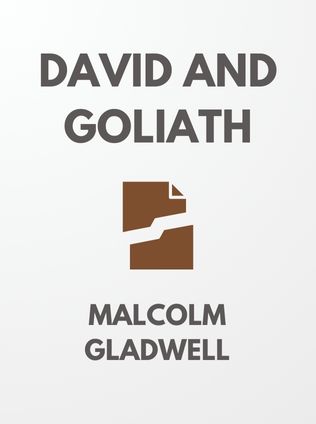
David and Goliath
Underdogs, Misfits, and the Art of Battling Giants
By Malcolm Gladwell
Published 10/2013
About the Author
Malcolm Gladwell is not just an author; he is a storyteller who weaves together psychology, sociology, and history to challenge our perceptions of the world. Born on September 3, 1963, in Fareham, Hampshire, England, Gladwell was the son of a Jamaican psychotherapist and a British mathematics professor. His family moved to Canada when he was six, where his inquisitive nature and analytical mind began to take shape. Gladwell's early interest in the complexities of human behavior and social dynamics was nurtured through his academic pursuits at Trinity College, University of Toronto, where he graduated with a degree in history.
Gladwell's career in journalism began with The American Spectator and later with The Washington Post, where he honed his skills in reporting on business and science. However, it was his work as a staff writer for The New Yorker, starting in 1996, that propelled him into the literary spotlight. His first book, The Tipping Point, published in 2000, became a cultural phenomenon, exploring how small actions can trigger massive social changes. This was followed by other bestsellers like Blink and Outliers, each delving into different aspects of decision-making, success, and human potential.
Gladwell's unique approach lies in his ability to connect seemingly unrelated ideas, drawing on a wide range of examples from various fields to illustrate his points. His writing is characterized by a deep curiosity about the human condition, a willingness to challenge conventional wisdom, and a talent for making complex ideas accessible to a broad audience. In David and Goliath: Underdogs, Misfits, and the Art of Battling Giants, Gladwell once again invites readers to reconsider their assumptions, this time about power, disadvantage, and what it means to face overwhelming odds.
Main Idea
David and Goliath is a profound exploration of the dynamics of power and the hidden strengths that lie within apparent weaknesses. At its core, the book challenges the traditional narrative of the underdog—the idea that those with fewer resources, less power, or physical disadvantages are inherently at a disadvantage in any conflict. Instead, Gladwell argues that these "disadvantages" can often be transformed into unique strengths that allow the underdog to prevail.
Using a combination of historical examples, personal stories, and psychological research, Gladwell demonstrates that the factors we often perceive as weaknesses—lack of resources, physical limitations, or social marginalization—can compel individuals and groups to develop strategies and skills that ultimately give them an edge over their more powerful opponents. This idea is encapsulated in the story of David and Goliath, where the seemingly weaker David triumphs over the giant Goliath by exploiting his own unique strengths and Goliath's vulnerabilities.
Throughout the book, Gladwell encourages readers to reconsider their understanding of power and to recognize that true strength often comes from unexpected sources. By embracing the challenges and difficulties that life presents, we can discover new ways to overcome obstacles and achieve success.
Table of Contents
- Introduction: Goliath
- The Advantages of Disadvantages (and the Disadvantages of Advantages)
- The Theory of Desirable Difficulty
- The Limits of Power
- Turning Weakness into Strength
- The Power of the Underdog
- Conclusion: The Real Meaning of the David and Goliath Story
Introduction: Goliath
The story of David and Goliath is one of the most well-known tales in history. It is a story of an underdog's triumph over a seemingly invincible opponent, a narrative that has been used for centuries to inspire and motivate those facing overwhelming odds. However, Malcolm Gladwell invites us to look deeper into this story and question the assumptions we have about what it means to be an underdog.
In the traditional telling of the story, David is portrayed as a weak, defenseless boy who, through sheer luck and divine intervention, defeats the giant warrior Goliath. But Gladwell challenges this interpretation by examining the details of the story more closely. He argues that David's victory was not a miraculous fluke but rather the result of strategic thinking and an understanding of his own strengths and Goliath's weaknesses.
Goliath, clad in heavy armor and armed with a massive sword, represents the conventional idea of power—strength, size, and weaponry. However, these same attributes made him slow, cumbersome, and vulnerable to an attack from a distance. David, on the other hand, was agile, quick, and skilled with a sling—a weapon that, when used effectively, could be deadly at a distance. By refusing to engage Goliath on his terms and instead using his own strengths to his advantage, David was able to turn what seemed like an impossible situation into a decisive victory.
This reinterpretation of the David and Goliath story serves as the foundation for the rest of the book. Gladwell uses it to introduce the central theme of his work: that the underdog's greatest weapon is often their ability to think differently, to approach problems from an unconventional angle, and to turn their perceived weaknesses into strengths.
Sign up for FREE and get access to 1,400+ books summaries.
You May Also Like
The Subtle Art of Not Giving a F*ck
A Counterintuitive Approach to Living a Good Life
By Mark MansonRich Dad Poor Dad
What the Rich Teach Their Kids About Money - That the Poor and Middle Class Do Not!
By Robert T. KiyosakiHow To Win Friends and Influence People
The All-Time Classic Manual Of People Skills
By Dale CarnegieFreakonomics
A Rogue Economist Explores the Hidden Side of Everything
By Steven D. Levitt and Stephen J. Dubner



















